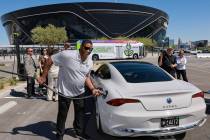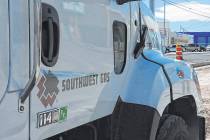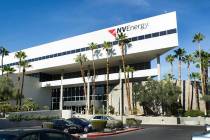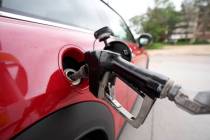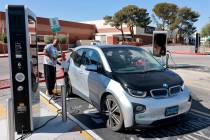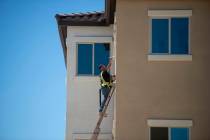Electric vehicles race in your backyard
If you like hot rods, you might be interested to know that there is an association of electric-powered drag racers who are affiliated with the National Hot Rod Association.
Over the last 12 years, the National Electric Drag Racing Association's backyard mechanics have tinkered in their garages and shared information online to develop astounding innovations outside the traditional automotive world. Several startup companies have emerged from these efforts with pioneering product lines that enable others to participate in high-performance electric vehicle drag racing.
NEDRA electric hot rods compete on NHRA-sanctioned quarter-mile drag strips alongside gasoline-powered dragsters. The group has been getting attention from the mass media, including hot rod magazines, the Speed Channel, the "Today" show, YouTube videos, and the Wall Street Journal. Many NEDRA records have been achieved locally at the Las Vegas Motor Speedway's quarter-mile drag strip, "The Strip."
One standout NEDRA racing team includes Bill Dube, Eva Hakansson, and top fuel motorcycle racer Scott Pollacheck, who have received much media attention recently for their Killacycle electric drag motorcycle. The Killacycle set a record time of 167.99 miles per hour in 7.89 seconds at Bandimere Speedway in Morrison, Colo., in October 2008. The team will attempt to set a new NEDRA electric motorcycle record at the Las Vegas Motor Speedway on Saturday and Sunday in conjunction with the Motorcycle Drag Racing Association. Visitors are invited to visit the Killacycle racing team in the pits, as well as see its new biodiesel-fueled portable charging system. Details can be found at www.killacycle.com.
Another local electric racing advocate is Bill Kuehl, a co-founder of the Las Vegas Electric Vehicle Association who has converted more than 200 electric vehicles. Kuehl helped organize the "Wicked Watts" drag racing events at the speedway that were part of the NEDRA racing circuit from 1999 to 2005 and still holds three NEDRA records with a converted 1985 Pontiac Fiero. Other local NEDRA record holders in Las Vegas include Al Sawyer, Jan Himber and Richard Furniss. For more information about electric drag racing in Las Vegas, go to www.lveva.org.
Following hot rod tradition, NEDRA racers like to rebuild lightweight vehicles from the 1970s and 1980s, choosing cars and trucks from an age before computer control systems were integrated into vehicle platforms. Popular car models for electric hot rod conversions include the Pontiac Fiero, Ford Pinto and Mustang, Geo Metro, Mazda RX7, Datsun 1200 and 240Z, Porsche 914 and 944, Volkswagen Rabbit, Honda Civic and the Nissan 240SX, among others.
NEDRA builders pull out the gasoline engine, lubrication system and all related components in the original vehicle, replacing them with lots of batteries, single- or dual-electric motor systems, a high-voltage/high-current motor speed controller, contactors and supplemental electrical components. The resulting vehicle is a full-sized version of an RC toy car on steroids.
Hundreds of battery cells are wired or welded together in series to scale up the amount of potential voltage to the battery pack in order to make the electric motor spin faster. Additional strings of battery cells are added in parallel to provide more current capacity (amperage or amps) that can add more torque to the motor, especially when launching the dragster from the starting line. These high-voltage packs are typically rated more than 300 volts, providing electrical current capacity of more than 1,000 amps continuous. This amount of power usually exceeds the normal voltage and current rating of the electric motor by two or three times, in order to push the motor as fast and hard as it will go without spinning it apart or melting the rotating commutator bars through the DC brushes. The "sweet spot" of electric drag racing is somewhere near these ultimate limits. Precision control of this power is achieved with a high-performance electronic motor speed controller.
NEDRA racers have led the way in the adoption of lithium-ion battery cell technology for high-performance racing by tediously welding together hundreds of small battery cells scavenged from DeWalt power tool battery packs and other low-cost battery sources.
Other breakthrough innovations have included high-voltage/high-current motor speed controllers that can channel the power required from the battery pack to the electric motor under pedal throttle control; the development of a manual brush ring advance system that can accelerate the electric motor more quickly while the dragster races up the strip; the adoption of ultracapacitor technology to enhance or replace electrochemical battery storage technology; the development of Power Factor Corrected battery recharging systems that can more efficiently pull current from an AC outlet to recharge high-energy battery packs; battery management systems that can regulate charging and discharging of individual cells within a battery pack; new performance-measuring instrumentation; and diagnostic tools to quickly spot problems and fix them as they occur.
All electric vehicles are welcome to race during NEDRA/NHRA-sanctioned events, provided that they pass the required NHRA safety inspection before being allowed onto the track.
For more information, including the NEDRA/NHRA handbook, visit the group's Web site at www.nedra.com.










